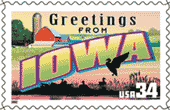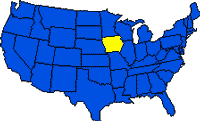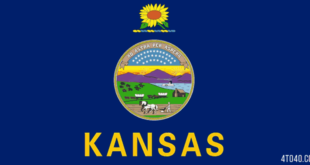 Iowa, in the heart of the Midwest, is a state in transition. Its location marks a transition from the eastern hardwood forests in its northeast to the prairies that stretch westward to the Rockies. With agricultural industries in its eastern cities, particularly Waterloo and DAVENPORT, it marks a transition between the eastern manufacturing belt and the less industrial West. The state is currently in transition from an agricultural economic base, both in terms of production and a whole array of agribusiness, to a more diversified economy. Iowa is the land between the rivers–the Missouri river and the Mississippi river. It is bordered by Minnesota, South Dakota, Nebraska, Missouri, Illinois, and Wisconsin.
Iowa, in the heart of the Midwest, is a state in transition. Its location marks a transition from the eastern hardwood forests in its northeast to the prairies that stretch westward to the Rockies. With agricultural industries in its eastern cities, particularly Waterloo and DAVENPORT, it marks a transition between the eastern manufacturing belt and the less industrial West. The state is currently in transition from an agricultural economic base, both in terms of production and a whole array of agribusiness, to a more diversified economy. Iowa is the land between the rivers–the Missouri river and the Mississippi river. It is bordered by Minnesota, South Dakota, Nebraska, Missouri, Illinois, and Wisconsin.
Land & Resources
Topography and Soils
 Iowa’s geological base is sedimentary rock laid down when much of North America was covered by an ancient sea. After the continent rose above sea level, erosion dissected what was essentially a plateau. Surface evidence of this process remains only in northeast Iowa, part of the Driftless Area that escaped glaciation during the Pleistocene (Ice Age).
Iowa’s geological base is sedimentary rock laid down when much of North America was covered by an ancient sea. After the continent rose above sea level, erosion dissected what was essentially a plateau. Surface evidence of this process remains only in northeast Iowa, part of the Driftless Area that escaped glaciation during the Pleistocene (Ice Age).
Glacial activity rearranged the landscape in much of the rest of the state. The Des Moines Lobe, a depositional feature in north central Iowa, is a flat area with poor drainage. Windblown loess deposits formed hills in western Iowa, and southern Iowa, not affected by the last continental glacier, has eroded into rolling to fairly steep hills. Iowa ranges in elevation from a high of 509 m (1,670 ft) in the northwest to a low of 146 m (480 ft) in the southeast. The average elevation is 335 m (l,100 ft), which is about the amount of local relief at the bluffs along the Mississippi in the northeast.
Rich, dark, deep (0.6 m/2-ft) prairie soils, high in organic content, cover most of the state. In fact, Iowa has more prime agricultural soil, mostly concentrated in the Des Moines Lobe, than any other state. Soil quality is less and the color lighter to the south and east. Because of glaciation, natural drainage is poor, leaving ponds and marshes, especially in the north and northwest.
Rivers and Lakes
In addition to Iowa’s border rivers, there are several other rivers that have played a significant role in transportation and as energy sources. These interior streams range in length from the Des Moines at 692 km (430 mi) to some just a few kilometers in length. The Iowa, Cedar, Wapsipinicon, Maquoketa, Skunk, and Des Moines have extensive drainage basins. The Coralville, Rathbun, Red Rock, and Saylorville reservoirs provide flood management as well as recreation and are the largest bodies of water in eastern, southern, and central Iowa. Only northwestern Iowa has any significant natural lakes; these provide recreational activities.
Climate
Iowa has a continental climate with extremes in both temperature and precipitation, as well as a potential for violent storms. Summertime highs average in the high 20 degrees C (low 80 degrees F) but can reach into the high 30 degrees C (over 100 degrees F), accompanied by high humidity. The west tends to get higher temperatures, the east higher humidity. In some years, periods of extended hot, humid conditions stress both crops and livestock. Average winter temperatures range from -10 degrees C to -4 degrees C (14 degrees F to 24 degrees F), but much colder temperatures can occur. The average frost-free season ranges from 170 days in the north to 140 days in the south.
Precipitation, usually occurring when moist air from the Gulf of Mexico meets colder air from the Pacific or Arctic, ranges from an annual average of 864 mm (34 in) in the southeast to 635 mm (25 in) in the northwest. The precipitation may be highly variable, with large amounts falling at once or with long periods of time between precipitation events. Thus, Iowa is susceptible to floods and droughts. Iowa also receives blizzards and tornadoes.
Tourism
The Iowa service sector, which showed substantial growth in the 1980s, now employs more people than the agricultural or manufacturing sectors. Much of the service-sector growth has been in insurance and financial services, especially in Des Moines, which is second only to Hartford, Conn., as an insurance center.
Only in recent years has Iowa developed a significant tourism office. Cities offering tourist attractions include Des Moines and Iowa City. A major lure for visitors is riverboat gambling on the Mississippi.
History
Paleo-Indians occupied what is now Iowa as long as 13,000 years ago, as soon as glacial ice retreated. These early people were hunters. Substantial archaeological evidence shows significant waves of Indian culture through Iowa and the surrounding areas of North America. The Woodland culture dominated from 500 BC to AD 800, with the Adena in the early part followed by the Hopewell. The Woodland peoples had small villages and practiced a primitive agriculture. They were succeeded by the Mississippian culture with the Oneonta tribe resident in Iowa. These people left the effigy mounds along the Mississippi. At the time of European contact, the Illinois, a northeast tribe, occupied extreme southeastern Iowa. Three Great Plains tribes–the IOWA, Santee, and Yankton– controlled the rest.
European Settlement
Although Louis JOLLIET and Jacques MARQUETTE traveled down the Mississippi River in 1673, significant European contact with Iowa came much later. Julien DUBUQUE, who mined lead along the Mississippi, established a permanent base in 1788. The land that was to become Iowa became part of the United States with the LOUISIANA PURCHASE in 1803, and the following year the LEWIS AND CLARK EXPEDITION traveled up the Missouri River. The SAUK and FOX (Mesquakie) tribes, forced into the Mississippi River valley from Wisconsin and Illinois by the oncoming pressure of white settlement, defeated the Iowa Indians and occupied their lands in the late 18th and early 19th centuries. Following the BLACK HAWK WAR of 1832, the resistance of these tribes to white settlers was broken, and the land was opened to pioneer settlement. The first legal settlement west of the Mississippi took place in 1833. Successive purchases from the Indians led to settlement throughout the area of the state in the 1830s and 40s–but not without confrontations, the last being the Spirit Lake Massacre of 1857. Just before this event (in 1856) the Mesquakies, who had been forced to move to Kansas, convinced the Iowa legislature to permit their repurchase of land along the Iowa River near Tama. The Mesquakie Settlement now covers about 13 sq km (5 sq mi).
Statehood and Settlement
Iowa gained territorial status in 1838, with its capital in Iowa City. Statehood came in 1846 with the boundaries extended west to the Missouri. The population was little more than 100,000, but the U.S. Congress needed a free state to admit in conjunction with a new slave state, Florida. The capital was moved to the more central location of Des Moines in 1857.
Early white settlement in Iowa mainly came from other states, especially Ohio and New York. The early settlers were involved in agriculture and commerce, and from the beginning, Iowa was linked commercially with the rest of the nation. Significantly, many of these early settlers, having already made previous moves, later moved westward again. The population grew rapidly, to 192,000 by 1850 and 675,000 by 1860, then to 1,194,000 by 1870.
The location of railroads quickly became an important political (and commercial) issue. Connections to the growing rail network became a requirement for the success of towns. River locations also were highly advantageous, as evidenced by the fact that all towns that became economically successful were both along rivers and attracted a rail line. Some rivers were important sources of energy, as connoted by the names of such towns as Cedar Rapids, Cedar Falls, and Iowa Falls.
The Civil War and Postwar Periods
The slavery issue and the American Civil War had a significant impact on Iowa, although the state suffered no actual fighting on its soil. At first a bastion of the Democratic party, Iowa swung strongly to the Republican party after its formation in Iowa in 1856. Iowans participated in the underground railway that helped runaway slaves escape to Canada. A few Iowans fought with John Brown in his attack on Harper’s Ferry, W. Va., in 1859. Almost 80,000 Iowans fought in the Civil War, a larger portion of Iowa’s population than that of any other Union state. After the war, suffrage was extended to blacks, and schools were integrated.
The years after the Civil War brought the completion of the settlement of Iowa and continued growth of the transportation network. The state achieved a fairly well distributed rural population, with the overwhelming majority actually involved in farming their own land. Iowa farming was commercial rather than subsistence from the beginning, and a number of problems pressed farmers in their efforts to profit. Floods, droughts, and pests plagued production, and economic depressions plagued their markets. Price gouging by railroads and distrust of banks and politicians led to the formation of agrarian movements, such as the GRANGER MOVEMENT. The development of the “Corn Belt” in the late 19th century illustrates the commodity compartmentalization of agriculture in the Midwest. By 1880 much of Iowa had adopted a corn-hog agricultural production pattern. Feed corn, fed on the site to a farmer’s own hogs, became the prime crop. The farmer then transported the hogs to the great slaughtering houses that developed in the major urban markets.
As the United States changed from an agricultural to an industrial country in the half century from 1870 to 1920, Iowa played a vital role in feeding the nation. Eastern Iowa became part of the manufacturing belt, particularly with the production of tractors and other farm equipment. Innovation, especially hybridization of corn and mechanization, paved the way for more efficient and productive farming.
The internal-combustion engine and electricity transformed life in Iowa, effectively reducing distances, increasing work capacities, and reorienting the scale of people’s daily activities. Farmers were no longer isolated, and their lives increasingly became focused on the larger towns.
The Recent Period
Through much of the 20th century Iowa agriculture has had the seemingly paradoxical position of always having marginal farmers in jeopardy while the top farmers do well. The people of the state seemed in general to be immune to major ebbs and flows of the economy, neither rising as high during booms nor falling as low during declines. The 1980s changed this pattern, as reduced commodity prices and high inflation jolted Iowa out of its complacency. Iowa’s economy suffered more than the national norm in the recessions of the late 1970s and early 1980s but failed to share proportionately in the economic expansion of the mid- and late-1980s. Belatedly the state has moved to diversify. Efforts to form high-tech havens in the Iowa City-Cedar Rapids and Des Moines-Ames areas have met with marginal success, but efforts to speed the transition of the meat-packing industry have traded well-paying jobs for poorly paid ones. A measure of the state’s desperation has been its move toward gambling. From a virtual prohibition on gambling Iowa has moved to become a gambling mecca–legalizing dog and horse-race betting, adding lottery games, easing the rules for bingo, and even establishing riverboat casino gambling.
Land
- Area: 145,754 sq km (56,276 sq mi); rank: 26th.
- Capital and largest city: Des Moines (1990 census pop., 193,187).
- Counties: 99.
- Elevations: highest–509 m (1,670 ft), in Osceola County; lowest–146 m (480 ft), at the Mississippi River.
 Kids Portal For Parents India Kids Network
Kids Portal For Parents India Kids Network









